Audit, Assurance and Compliance
VerifiedAdded on 2023/06/12
|15
|3249
|439
AI Summary
The report analyses the compliance of ASX corporate governance principles by Qantas Airways and the risk involved in the business of the company. It also states the business strategies, market overview and industry overview of the company.
Contribute Materials
Your contribution can guide someone’s learning journey. Share your
documents today.
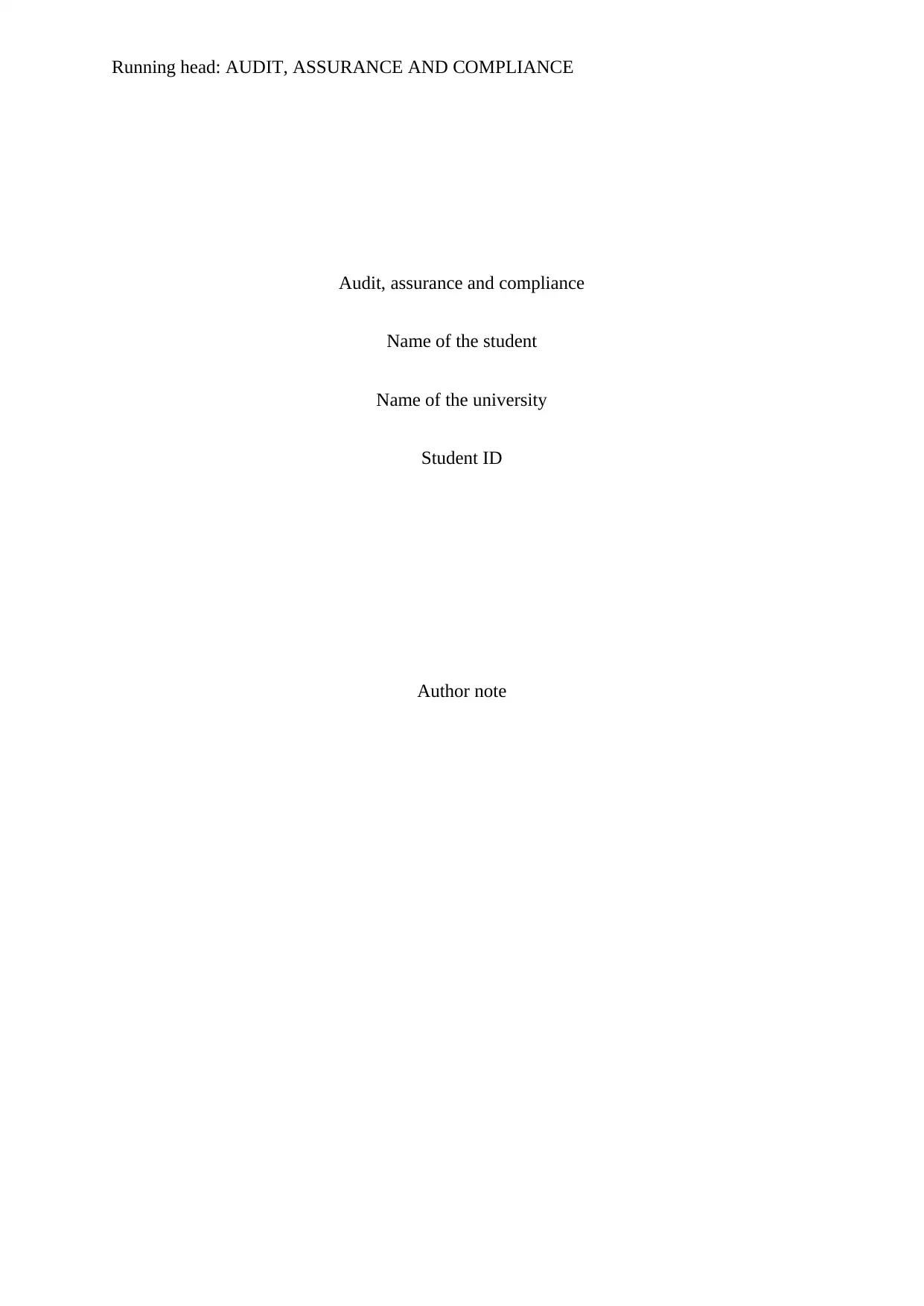
Running head: AUDIT, ASSURANCE AND COMPLIANCE
Audit, assurance and compliance
Name of the student
Name of the university
Student ID
Author note
Audit, assurance and compliance
Name of the student
Name of the university
Student ID
Author note
Secure Best Marks with AI Grader
Need help grading? Try our AI Grader for instant feedback on your assignments.
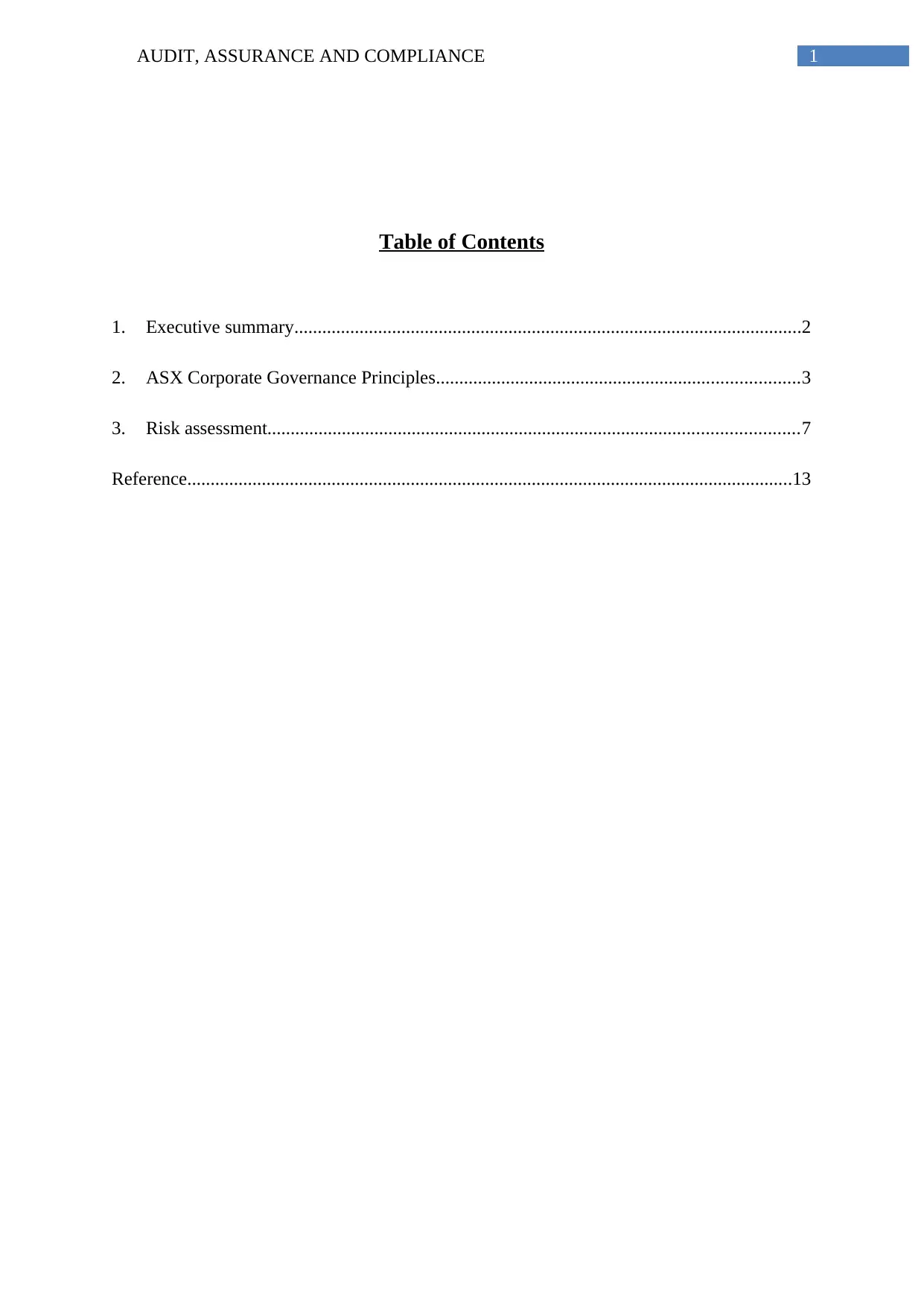
1AUDIT, ASSURANCE AND COMPLIANCE
Table of Contents
1. Executive summary.............................................................................................................2
2. ASX Corporate Governance Principles..............................................................................3
3. Risk assessment..................................................................................................................7
Reference..................................................................................................................................13
Table of Contents
1. Executive summary.............................................................................................................2
2. ASX Corporate Governance Principles..............................................................................3
3. Risk assessment..................................................................................................................7
Reference..................................................................................................................................13
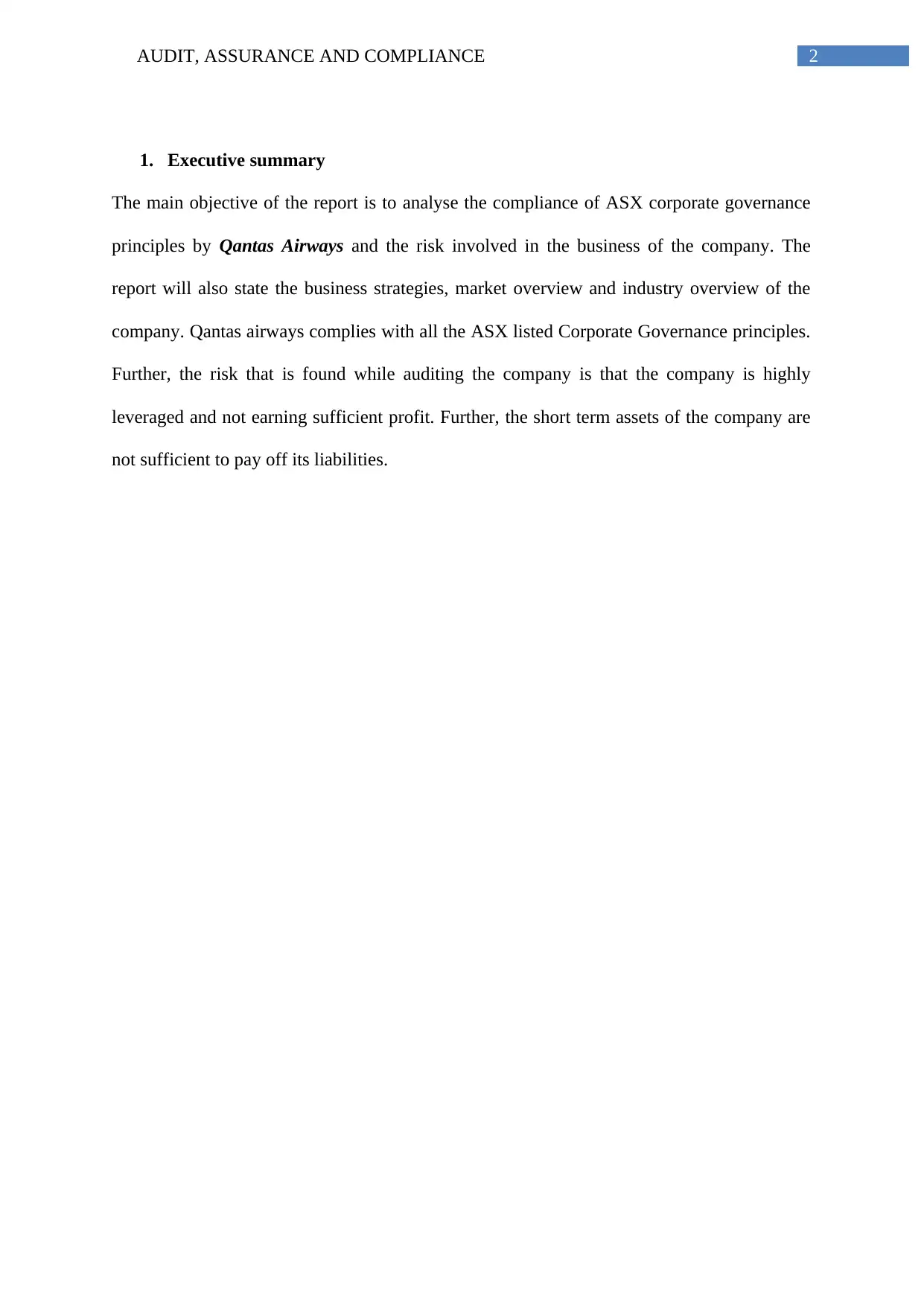
2AUDIT, ASSURANCE AND COMPLIANCE
1. Executive summary
The main objective of the report is to analyse the compliance of ASX corporate governance
principles by Qantas Airways and the risk involved in the business of the company. The
report will also state the business strategies, market overview and industry overview of the
company. Qantas airways complies with all the ASX listed Corporate Governance principles.
Further, the risk that is found while auditing the company is that the company is highly
leveraged and not earning sufficient profit. Further, the short term assets of the company are
not sufficient to pay off its liabilities.
1. Executive summary
The main objective of the report is to analyse the compliance of ASX corporate governance
principles by Qantas Airways and the risk involved in the business of the company. The
report will also state the business strategies, market overview and industry overview of the
company. Qantas airways complies with all the ASX listed Corporate Governance principles.
Further, the risk that is found while auditing the company is that the company is highly
leveraged and not earning sufficient profit. Further, the short term assets of the company are
not sufficient to pay off its liabilities.
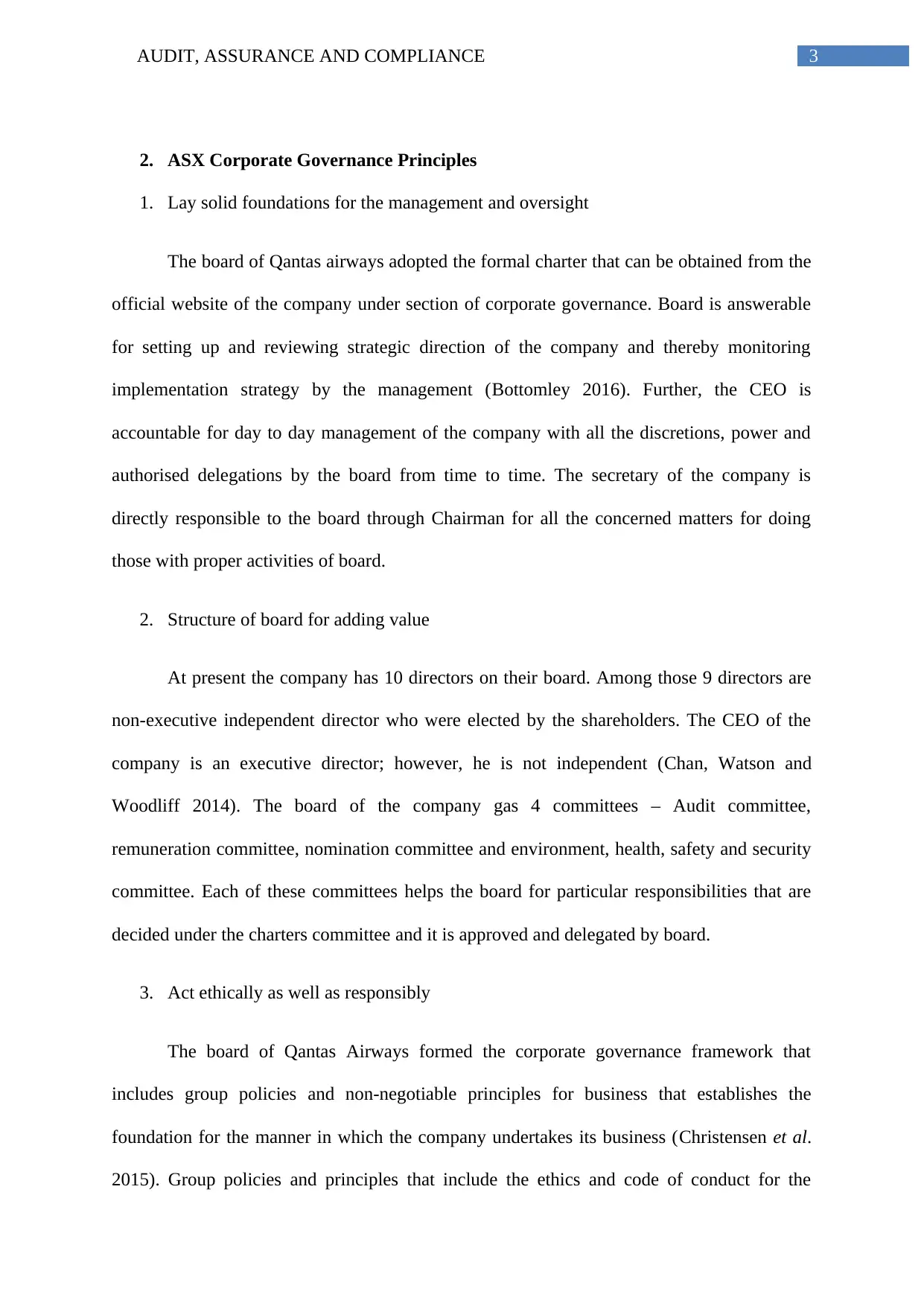
3AUDIT, ASSURANCE AND COMPLIANCE
2. ASX Corporate Governance Principles
1. Lay solid foundations for the management and oversight
The board of Qantas airways adopted the formal charter that can be obtained from the
official website of the company under section of corporate governance. Board is answerable
for setting up and reviewing strategic direction of the company and thereby monitoring
implementation strategy by the management (Bottomley 2016). Further, the CEO is
accountable for day to day management of the company with all the discretions, power and
authorised delegations by the board from time to time. The secretary of the company is
directly responsible to the board through Chairman for all the concerned matters for doing
those with proper activities of board.
2. Structure of board for adding value
At present the company has 10 directors on their board. Among those 9 directors are
non-executive independent director who were elected by the shareholders. The CEO of the
company is an executive director; however, he is not independent (Chan, Watson and
Woodliff 2014). The board of the company gas 4 committees – Audit committee,
remuneration committee, nomination committee and environment, health, safety and security
committee. Each of these committees helps the board for particular responsibilities that are
decided under the charters committee and it is approved and delegated by board.
3. Act ethically as well as responsibly
The board of Qantas Airways formed the corporate governance framework that
includes group policies and non-negotiable principles for business that establishes the
foundation for the manner in which the company undertakes its business (Christensen et al.
2015). Group policies and principles that include the ethics and code of conduct for the
2. ASX Corporate Governance Principles
1. Lay solid foundations for the management and oversight
The board of Qantas airways adopted the formal charter that can be obtained from the
official website of the company under section of corporate governance. Board is answerable
for setting up and reviewing strategic direction of the company and thereby monitoring
implementation strategy by the management (Bottomley 2016). Further, the CEO is
accountable for day to day management of the company with all the discretions, power and
authorised delegations by the board from time to time. The secretary of the company is
directly responsible to the board through Chairman for all the concerned matters for doing
those with proper activities of board.
2. Structure of board for adding value
At present the company has 10 directors on their board. Among those 9 directors are
non-executive independent director who were elected by the shareholders. The CEO of the
company is an executive director; however, he is not independent (Chan, Watson and
Woodliff 2014). The board of the company gas 4 committees – Audit committee,
remuneration committee, nomination committee and environment, health, safety and security
committee. Each of these committees helps the board for particular responsibilities that are
decided under the charters committee and it is approved and delegated by board.
3. Act ethically as well as responsibly
The board of Qantas Airways formed the corporate governance framework that
includes group policies and non-negotiable principles for business that establishes the
foundation for the manner in which the company undertakes its business (Christensen et al.
2015). Group policies and principles that include the ethics and code of conduct for the
Secure Best Marks with AI Grader
Need help grading? Try our AI Grader for instant feedback on your assignments.
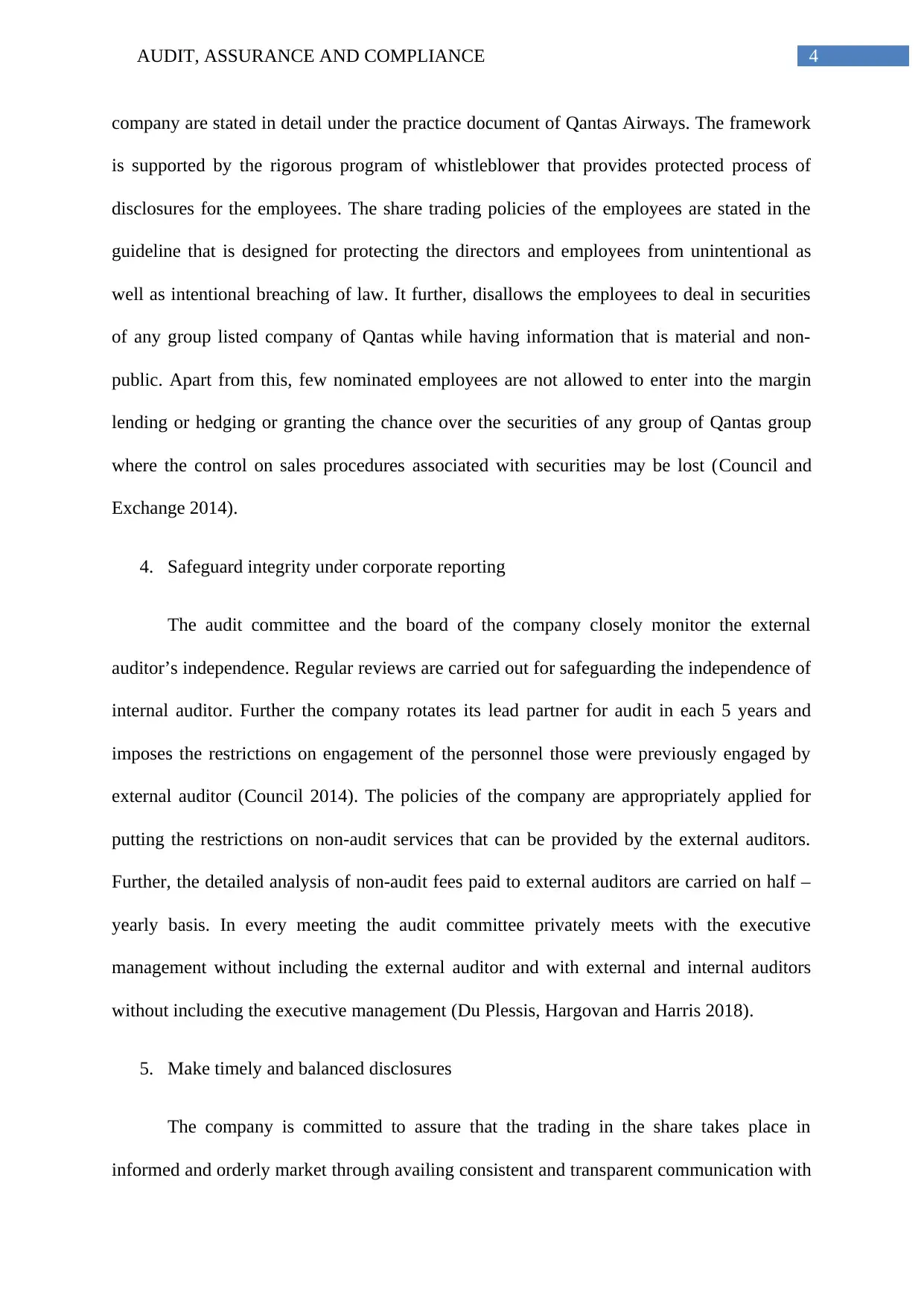
4AUDIT, ASSURANCE AND COMPLIANCE
company are stated in detail under the practice document of Qantas Airways. The framework
is supported by the rigorous program of whistleblower that provides protected process of
disclosures for the employees. The share trading policies of the employees are stated in the
guideline that is designed for protecting the directors and employees from unintentional as
well as intentional breaching of law. It further, disallows the employees to deal in securities
of any group listed company of Qantas while having information that is material and non-
public. Apart from this, few nominated employees are not allowed to enter into the margin
lending or hedging or granting the chance over the securities of any group of Qantas group
where the control on sales procedures associated with securities may be lost (Council and
Exchange 2014).
4. Safeguard integrity under corporate reporting
The audit committee and the board of the company closely monitor the external
auditor’s independence. Regular reviews are carried out for safeguarding the independence of
internal auditor. Further the company rotates its lead partner for audit in each 5 years and
imposes the restrictions on engagement of the personnel those were previously engaged by
external auditor (Council 2014). The policies of the company are appropriately applied for
putting the restrictions on non-audit services that can be provided by the external auditors.
Further, the detailed analysis of non-audit fees paid to external auditors are carried on half –
yearly basis. In every meeting the audit committee privately meets with the executive
management without including the external auditor and with external and internal auditors
without including the executive management (Du Plessis, Hargovan and Harris 2018).
5. Make timely and balanced disclosures
The company is committed to assure that the trading in the share takes place in
informed and orderly market through availing consistent and transparent communication with
company are stated in detail under the practice document of Qantas Airways. The framework
is supported by the rigorous program of whistleblower that provides protected process of
disclosures for the employees. The share trading policies of the employees are stated in the
guideline that is designed for protecting the directors and employees from unintentional as
well as intentional breaching of law. It further, disallows the employees to deal in securities
of any group listed company of Qantas while having information that is material and non-
public. Apart from this, few nominated employees are not allowed to enter into the margin
lending or hedging or granting the chance over the securities of any group of Qantas group
where the control on sales procedures associated with securities may be lost (Council and
Exchange 2014).
4. Safeguard integrity under corporate reporting
The audit committee and the board of the company closely monitor the external
auditor’s independence. Regular reviews are carried out for safeguarding the independence of
internal auditor. Further the company rotates its lead partner for audit in each 5 years and
imposes the restrictions on engagement of the personnel those were previously engaged by
external auditor (Council 2014). The policies of the company are appropriately applied for
putting the restrictions on non-audit services that can be provided by the external auditors.
Further, the detailed analysis of non-audit fees paid to external auditors are carried on half –
yearly basis. In every meeting the audit committee privately meets with the executive
management without including the external auditor and with external and internal auditors
without including the executive management (Du Plessis, Hargovan and Harris 2018).
5. Make timely and balanced disclosures
The company is committed to assure that the trading in the share takes place in
informed and orderly market through availing consistent and transparent communication with
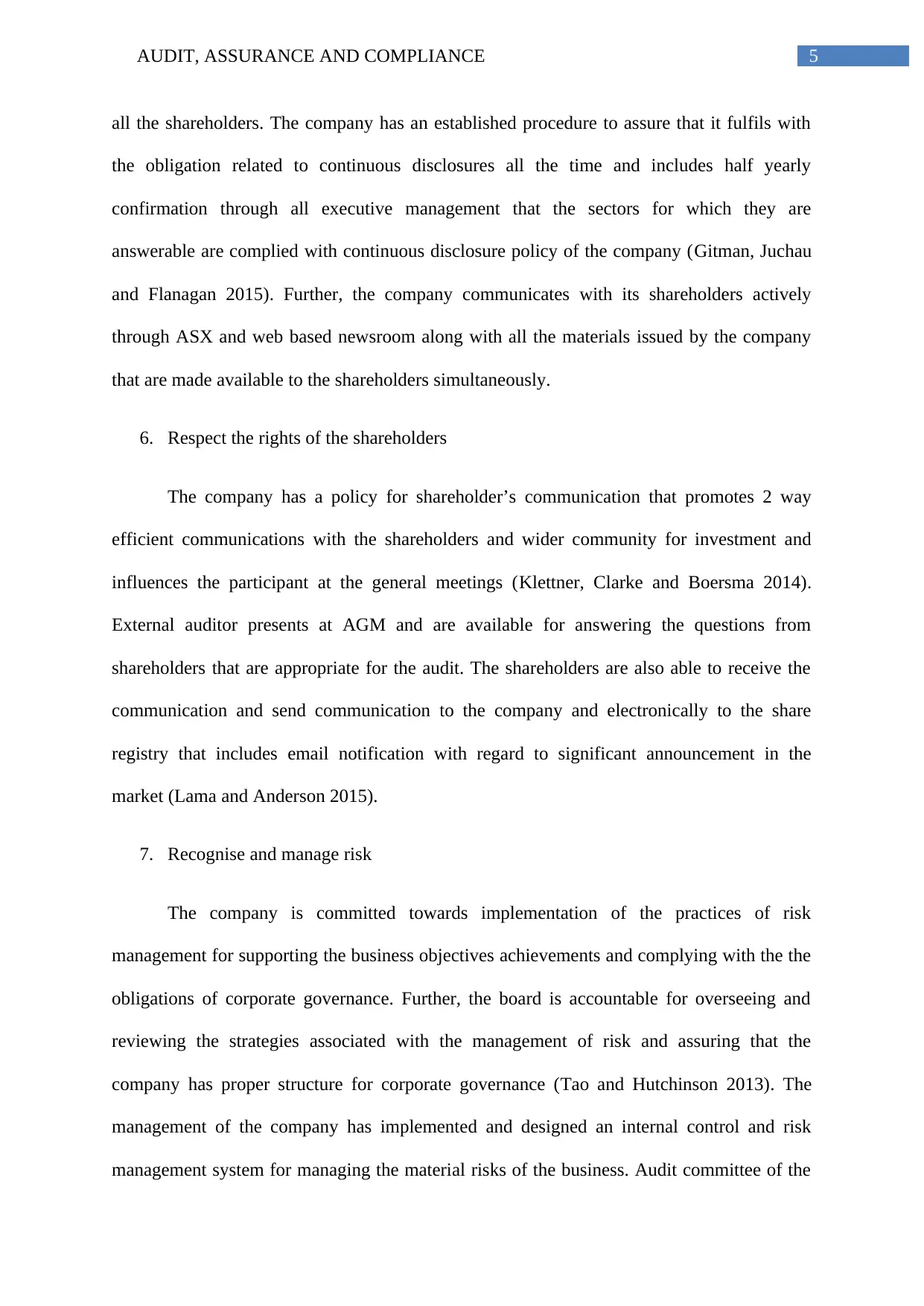
5AUDIT, ASSURANCE AND COMPLIANCE
all the shareholders. The company has an established procedure to assure that it fulfils with
the obligation related to continuous disclosures all the time and includes half yearly
confirmation through all executive management that the sectors for which they are
answerable are complied with continuous disclosure policy of the company (Gitman, Juchau
and Flanagan 2015). Further, the company communicates with its shareholders actively
through ASX and web based newsroom along with all the materials issued by the company
that are made available to the shareholders simultaneously.
6. Respect the rights of the shareholders
The company has a policy for shareholder’s communication that promotes 2 way
efficient communications with the shareholders and wider community for investment and
influences the participant at the general meetings (Klettner, Clarke and Boersma 2014).
External auditor presents at AGM and are available for answering the questions from
shareholders that are appropriate for the audit. The shareholders are also able to receive the
communication and send communication to the company and electronically to the share
registry that includes email notification with regard to significant announcement in the
market (Lama and Anderson 2015).
7. Recognise and manage risk
The company is committed towards implementation of the practices of risk
management for supporting the business objectives achievements and complying with the the
obligations of corporate governance. Further, the board is accountable for overseeing and
reviewing the strategies associated with the management of risk and assuring that the
company has proper structure for corporate governance (Tao and Hutchinson 2013). The
management of the company has implemented and designed an internal control and risk
management system for managing the material risks of the business. Audit committee of the
all the shareholders. The company has an established procedure to assure that it fulfils with
the obligation related to continuous disclosures all the time and includes half yearly
confirmation through all executive management that the sectors for which they are
answerable are complied with continuous disclosure policy of the company (Gitman, Juchau
and Flanagan 2015). Further, the company communicates with its shareholders actively
through ASX and web based newsroom along with all the materials issued by the company
that are made available to the shareholders simultaneously.
6. Respect the rights of the shareholders
The company has a policy for shareholder’s communication that promotes 2 way
efficient communications with the shareholders and wider community for investment and
influences the participant at the general meetings (Klettner, Clarke and Boersma 2014).
External auditor presents at AGM and are available for answering the questions from
shareholders that are appropriate for the audit. The shareholders are also able to receive the
communication and send communication to the company and electronically to the share
registry that includes email notification with regard to significant announcement in the
market (Lama and Anderson 2015).
7. Recognise and manage risk
The company is committed towards implementation of the practices of risk
management for supporting the business objectives achievements and complying with the the
obligations of corporate governance. Further, the board is accountable for overseeing and
reviewing the strategies associated with the management of risk and assuring that the
company has proper structure for corporate governance (Tao and Hutchinson 2013). The
management of the company has implemented and designed an internal control and risk
management system for managing the material risks of the business. Audit committee of the
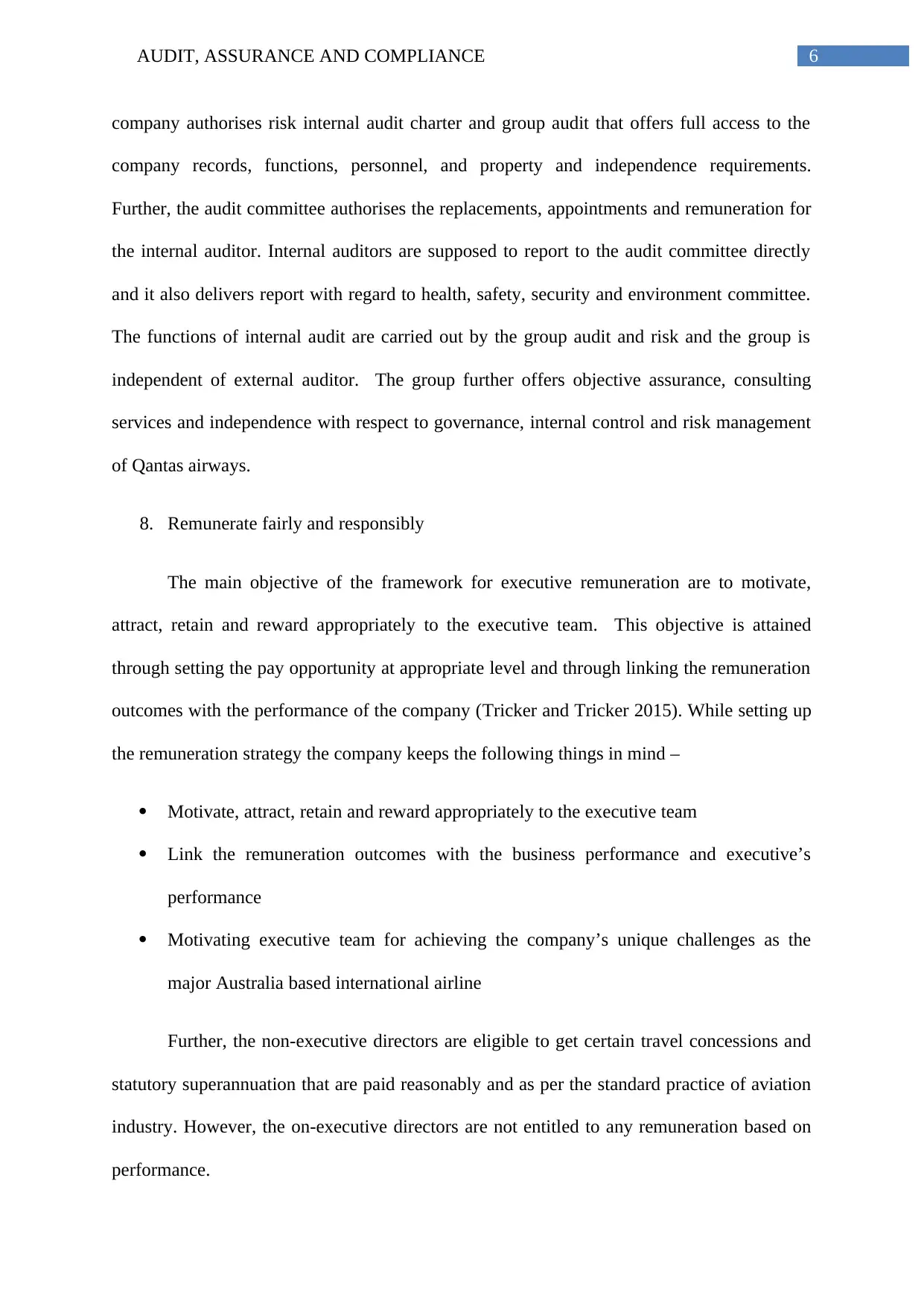
6AUDIT, ASSURANCE AND COMPLIANCE
company authorises risk internal audit charter and group audit that offers full access to the
company records, functions, personnel, and property and independence requirements.
Further, the audit committee authorises the replacements, appointments and remuneration for
the internal auditor. Internal auditors are supposed to report to the audit committee directly
and it also delivers report with regard to health, safety, security and environment committee.
The functions of internal audit are carried out by the group audit and risk and the group is
independent of external auditor. The group further offers objective assurance, consulting
services and independence with respect to governance, internal control and risk management
of Qantas airways.
8. Remunerate fairly and responsibly
The main objective of the framework for executive remuneration are to motivate,
attract, retain and reward appropriately to the executive team. This objective is attained
through setting the pay opportunity at appropriate level and through linking the remuneration
outcomes with the performance of the company (Tricker and Tricker 2015). While setting up
the remuneration strategy the company keeps the following things in mind –
Motivate, attract, retain and reward appropriately to the executive team
Link the remuneration outcomes with the business performance and executive’s
performance
Motivating executive team for achieving the company’s unique challenges as the
major Australia based international airline
Further, the non-executive directors are eligible to get certain travel concessions and
statutory superannuation that are paid reasonably and as per the standard practice of aviation
industry. However, the on-executive directors are not entitled to any remuneration based on
performance.
company authorises risk internal audit charter and group audit that offers full access to the
company records, functions, personnel, and property and independence requirements.
Further, the audit committee authorises the replacements, appointments and remuneration for
the internal auditor. Internal auditors are supposed to report to the audit committee directly
and it also delivers report with regard to health, safety, security and environment committee.
The functions of internal audit are carried out by the group audit and risk and the group is
independent of external auditor. The group further offers objective assurance, consulting
services and independence with respect to governance, internal control and risk management
of Qantas airways.
8. Remunerate fairly and responsibly
The main objective of the framework for executive remuneration are to motivate,
attract, retain and reward appropriately to the executive team. This objective is attained
through setting the pay opportunity at appropriate level and through linking the remuneration
outcomes with the performance of the company (Tricker and Tricker 2015). While setting up
the remuneration strategy the company keeps the following things in mind –
Motivate, attract, retain and reward appropriately to the executive team
Link the remuneration outcomes with the business performance and executive’s
performance
Motivating executive team for achieving the company’s unique challenges as the
major Australia based international airline
Further, the non-executive directors are eligible to get certain travel concessions and
statutory superannuation that are paid reasonably and as per the standard practice of aviation
industry. However, the on-executive directors are not entitled to any remuneration based on
performance.
Paraphrase This Document
Need a fresh take? Get an instant paraphrase of this document with our AI Paraphraser
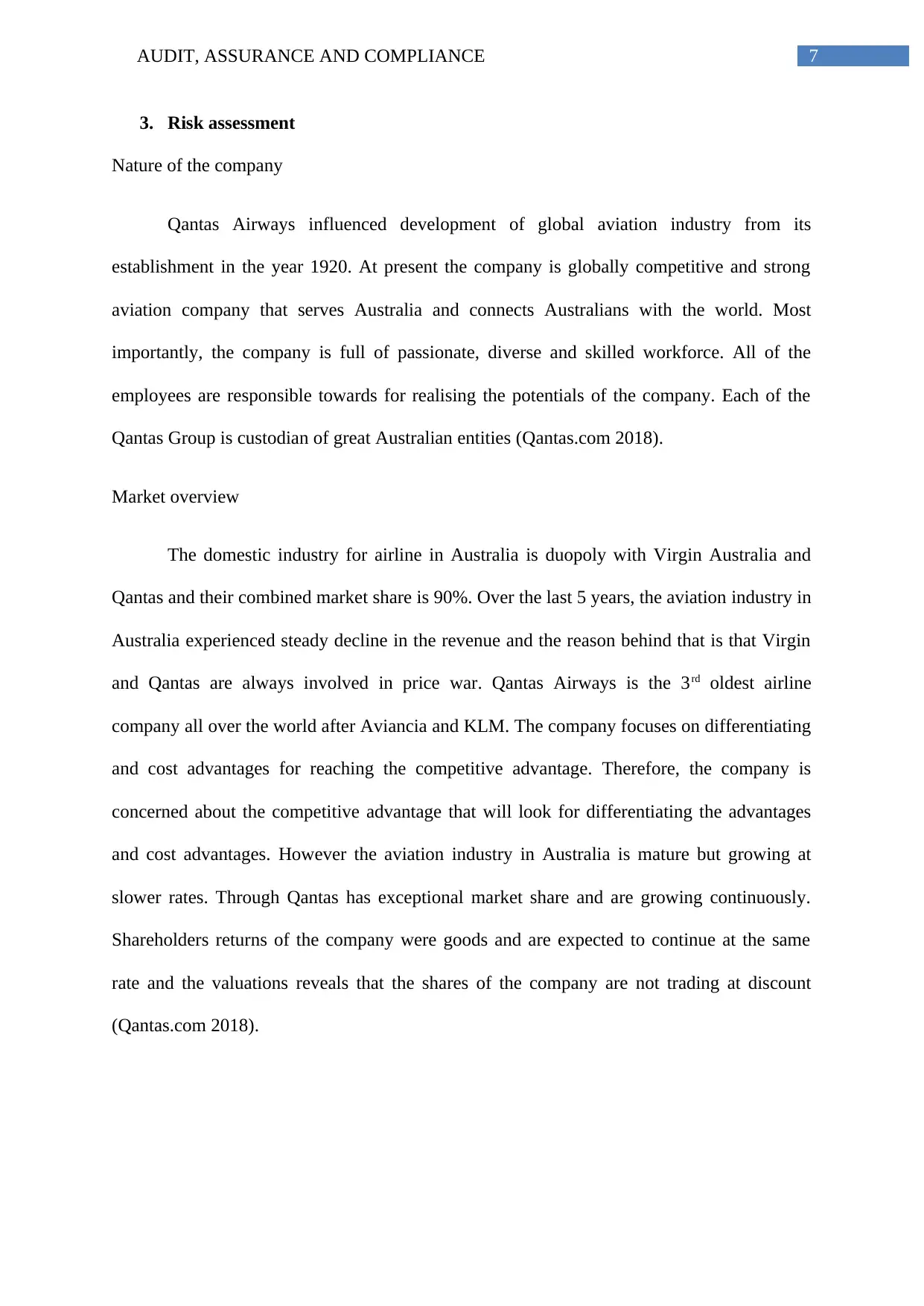
7AUDIT, ASSURANCE AND COMPLIANCE
3. Risk assessment
Nature of the company
Qantas Airways influenced development of global aviation industry from its
establishment in the year 1920. At present the company is globally competitive and strong
aviation company that serves Australia and connects Australians with the world. Most
importantly, the company is full of passionate, diverse and skilled workforce. All of the
employees are responsible towards for realising the potentials of the company. Each of the
Qantas Group is custodian of great Australian entities (Qantas.com 2018).
Market overview
The domestic industry for airline in Australia is duopoly with Virgin Australia and
Qantas and their combined market share is 90%. Over the last 5 years, the aviation industry in
Australia experienced steady decline in the revenue and the reason behind that is that Virgin
and Qantas are always involved in price war. Qantas Airways is the 3rd oldest airline
company all over the world after Aviancia and KLM. The company focuses on differentiating
and cost advantages for reaching the competitive advantage. Therefore, the company is
concerned about the competitive advantage that will look for differentiating the advantages
and cost advantages. However the aviation industry in Australia is mature but growing at
slower rates. Through Qantas has exceptional market share and are growing continuously.
Shareholders returns of the company were goods and are expected to continue at the same
rate and the valuations reveals that the shares of the company are not trading at discount
(Qantas.com 2018).
3. Risk assessment
Nature of the company
Qantas Airways influenced development of global aviation industry from its
establishment in the year 1920. At present the company is globally competitive and strong
aviation company that serves Australia and connects Australians with the world. Most
importantly, the company is full of passionate, diverse and skilled workforce. All of the
employees are responsible towards for realising the potentials of the company. Each of the
Qantas Group is custodian of great Australian entities (Qantas.com 2018).
Market overview
The domestic industry for airline in Australia is duopoly with Virgin Australia and
Qantas and their combined market share is 90%. Over the last 5 years, the aviation industry in
Australia experienced steady decline in the revenue and the reason behind that is that Virgin
and Qantas are always involved in price war. Qantas Airways is the 3rd oldest airline
company all over the world after Aviancia and KLM. The company focuses on differentiating
and cost advantages for reaching the competitive advantage. Therefore, the company is
concerned about the competitive advantage that will look for differentiating the advantages
and cost advantages. However the aviation industry in Australia is mature but growing at
slower rates. Through Qantas has exceptional market share and are growing continuously.
Shareholders returns of the company were goods and are expected to continue at the same
rate and the valuations reveals that the shares of the company are not trading at discount
(Qantas.com 2018).
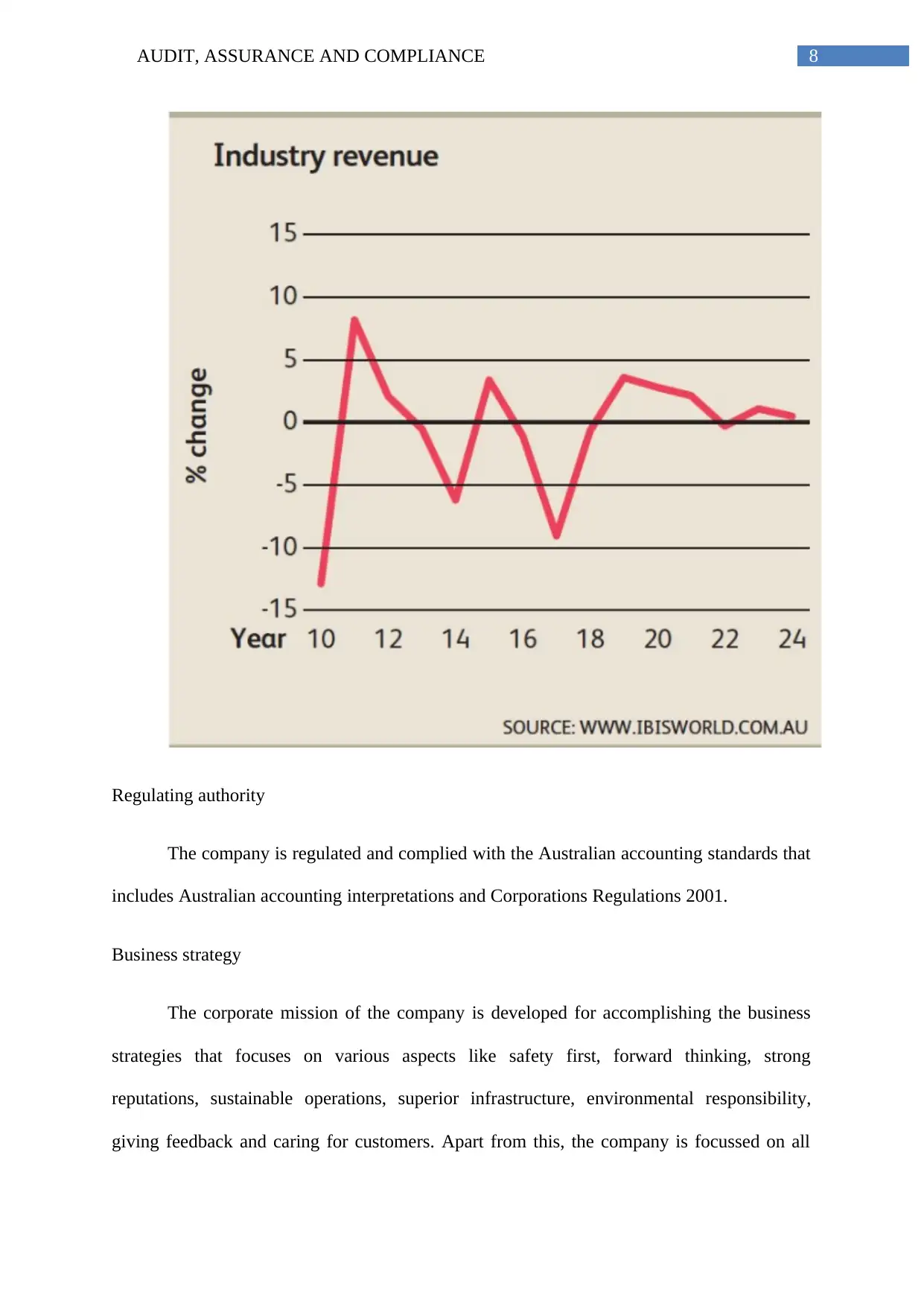
8AUDIT, ASSURANCE AND COMPLIANCE
Regulating authority
The company is regulated and complied with the Australian accounting standards that
includes Australian accounting interpretations and Corporations Regulations 2001.
Business strategy
The corporate mission of the company is developed for accomplishing the business
strategies that focuses on various aspects like safety first, forward thinking, strong
reputations, sustainable operations, superior infrastructure, environmental responsibility,
giving feedback and caring for customers. Apart from this, the company is focussed on all
Regulating authority
The company is regulated and complied with the Australian accounting standards that
includes Australian accounting interpretations and Corporations Regulations 2001.
Business strategy
The corporate mission of the company is developed for accomplishing the business
strategies that focuses on various aspects like safety first, forward thinking, strong
reputations, sustainable operations, superior infrastructure, environmental responsibility,
giving feedback and caring for customers. Apart from this, the company is focussed on all
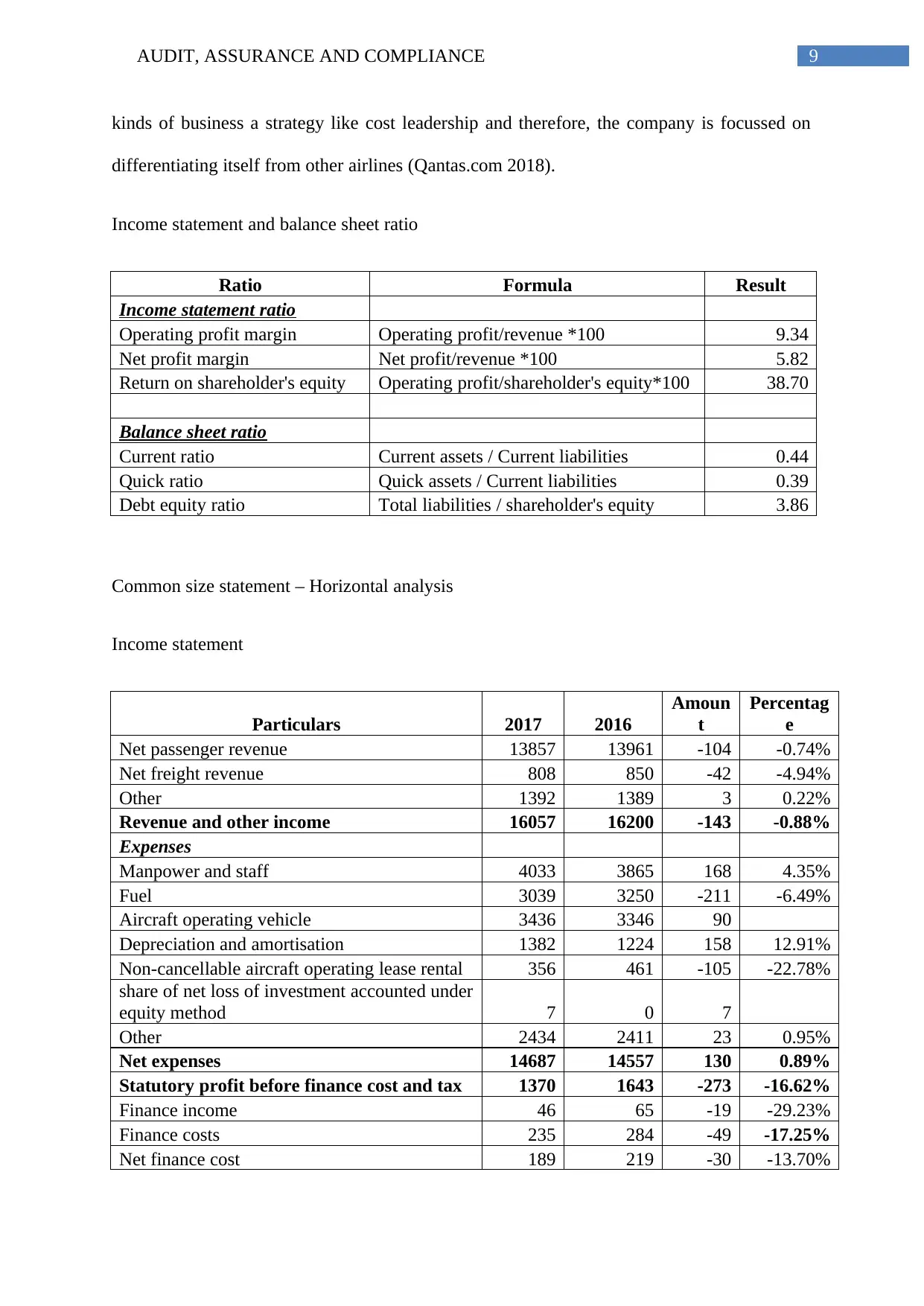
9AUDIT, ASSURANCE AND COMPLIANCE
kinds of business a strategy like cost leadership and therefore, the company is focussed on
differentiating itself from other airlines (Qantas.com 2018).
Income statement and balance sheet ratio
Ratio Formula Result
Income statement ratio
Operating profit margin Operating profit/revenue *100 9.34
Net profit margin Net profit/revenue *100 5.82
Return on shareholder's equity Operating profit/shareholder's equity*100 38.70
Balance sheet ratio
Current ratio Current assets / Current liabilities 0.44
Quick ratio Quick assets / Current liabilities 0.39
Debt equity ratio Total liabilities / shareholder's equity 3.86
Common size statement – Horizontal analysis
Income statement
Particulars 2017 2016
Amoun
t
Percentag
e
Net passenger revenue 13857 13961 -104 -0.74%
Net freight revenue 808 850 -42 -4.94%
Other 1392 1389 3 0.22%
Revenue and other income 16057 16200 -143 -0.88%
Expenses
Manpower and staff 4033 3865 168 4.35%
Fuel 3039 3250 -211 -6.49%
Aircraft operating vehicle 3436 3346 90
Depreciation and amortisation 1382 1224 158 12.91%
Non-cancellable aircraft operating lease rental 356 461 -105 -22.78%
share of net loss of investment accounted under
equity method 7 0 7
Other 2434 2411 23 0.95%
Net expenses 14687 14557 130 0.89%
Statutory profit before finance cost and tax 1370 1643 -273 -16.62%
Finance income 46 65 -19 -29.23%
Finance costs 235 284 -49 -17.25%
Net finance cost 189 219 -30 -13.70%
kinds of business a strategy like cost leadership and therefore, the company is focussed on
differentiating itself from other airlines (Qantas.com 2018).
Income statement and balance sheet ratio
Ratio Formula Result
Income statement ratio
Operating profit margin Operating profit/revenue *100 9.34
Net profit margin Net profit/revenue *100 5.82
Return on shareholder's equity Operating profit/shareholder's equity*100 38.70
Balance sheet ratio
Current ratio Current assets / Current liabilities 0.44
Quick ratio Quick assets / Current liabilities 0.39
Debt equity ratio Total liabilities / shareholder's equity 3.86
Common size statement – Horizontal analysis
Income statement
Particulars 2017 2016
Amoun
t
Percentag
e
Net passenger revenue 13857 13961 -104 -0.74%
Net freight revenue 808 850 -42 -4.94%
Other 1392 1389 3 0.22%
Revenue and other income 16057 16200 -143 -0.88%
Expenses
Manpower and staff 4033 3865 168 4.35%
Fuel 3039 3250 -211 -6.49%
Aircraft operating vehicle 3436 3346 90
Depreciation and amortisation 1382 1224 158 12.91%
Non-cancellable aircraft operating lease rental 356 461 -105 -22.78%
share of net loss of investment accounted under
equity method 7 0 7
Other 2434 2411 23 0.95%
Net expenses 14687 14557 130 0.89%
Statutory profit before finance cost and tax 1370 1643 -273 -16.62%
Finance income 46 65 -19 -29.23%
Finance costs 235 284 -49 -17.25%
Net finance cost 189 219 -30 -13.70%
Secure Best Marks with AI Grader
Need help grading? Try our AI Grader for instant feedback on your assignments.
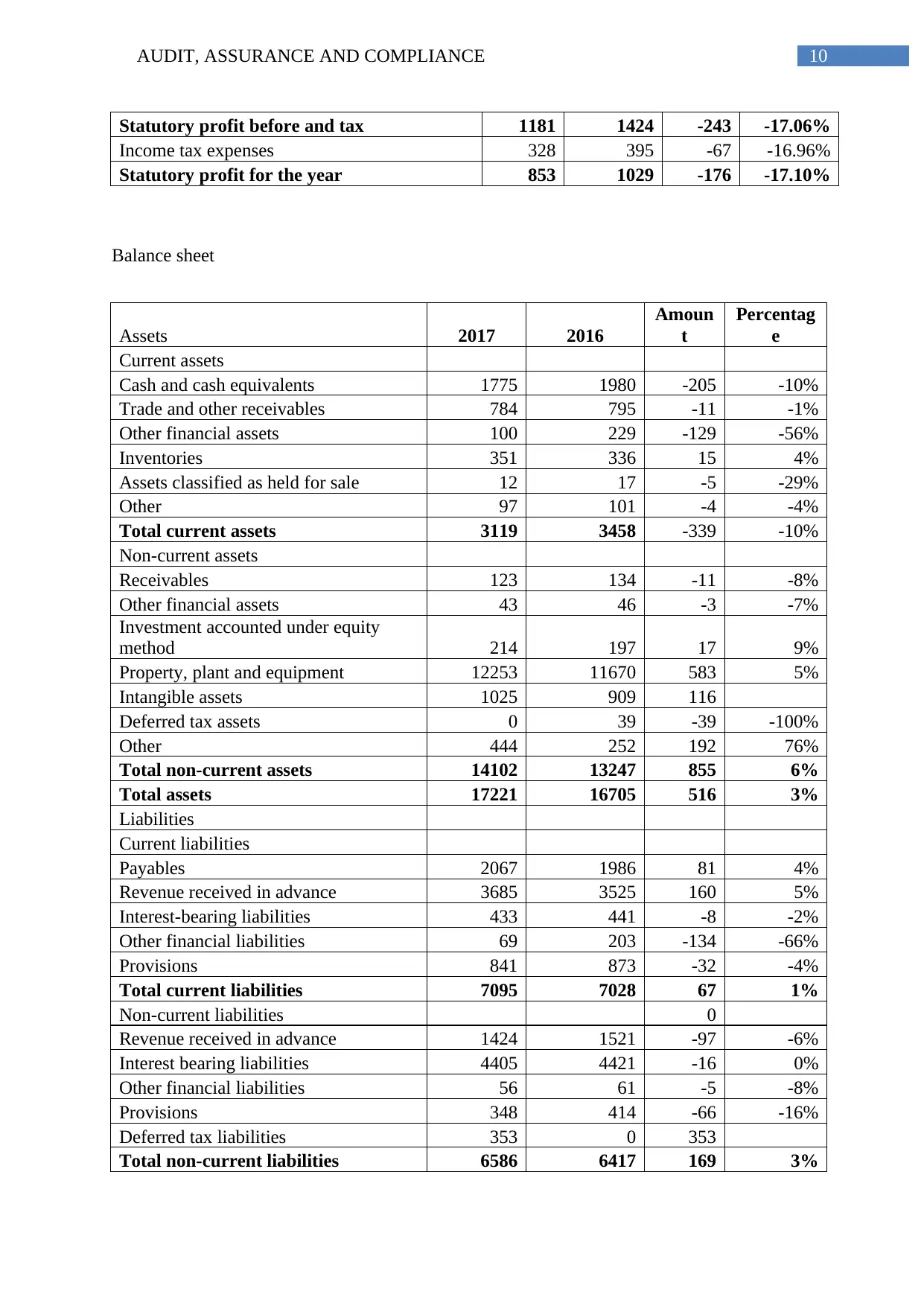
10AUDIT, ASSURANCE AND COMPLIANCE
Statutory profit before and tax 1181 1424 -243 -17.06%
Income tax expenses 328 395 -67 -16.96%
Statutory profit for the year 853 1029 -176 -17.10%
Balance sheet
Assets 2017 2016
Amoun
t
Percentag
e
Current assets
Cash and cash equivalents 1775 1980 -205 -10%
Trade and other receivables 784 795 -11 -1%
Other financial assets 100 229 -129 -56%
Inventories 351 336 15 4%
Assets classified as held for sale 12 17 -5 -29%
Other 97 101 -4 -4%
Total current assets 3119 3458 -339 -10%
Non-current assets
Receivables 123 134 -11 -8%
Other financial assets 43 46 -3 -7%
Investment accounted under equity
method 214 197 17 9%
Property, plant and equipment 12253 11670 583 5%
Intangible assets 1025 909 116
Deferred tax assets 0 39 -39 -100%
Other 444 252 192 76%
Total non-current assets 14102 13247 855 6%
Total assets 17221 16705 516 3%
Liabilities
Current liabilities
Payables 2067 1986 81 4%
Revenue received in advance 3685 3525 160 5%
Interest-bearing liabilities 433 441 -8 -2%
Other financial liabilities 69 203 -134 -66%
Provisions 841 873 -32 -4%
Total current liabilities 7095 7028 67 1%
Non-current liabilities 0
Revenue received in advance 1424 1521 -97 -6%
Interest bearing liabilities 4405 4421 -16 0%
Other financial liabilities 56 61 -5 -8%
Provisions 348 414 -66 -16%
Deferred tax liabilities 353 0 353
Total non-current liabilities 6586 6417 169 3%
Statutory profit before and tax 1181 1424 -243 -17.06%
Income tax expenses 328 395 -67 -16.96%
Statutory profit for the year 853 1029 -176 -17.10%
Balance sheet
Assets 2017 2016
Amoun
t
Percentag
e
Current assets
Cash and cash equivalents 1775 1980 -205 -10%
Trade and other receivables 784 795 -11 -1%
Other financial assets 100 229 -129 -56%
Inventories 351 336 15 4%
Assets classified as held for sale 12 17 -5 -29%
Other 97 101 -4 -4%
Total current assets 3119 3458 -339 -10%
Non-current assets
Receivables 123 134 -11 -8%
Other financial assets 43 46 -3 -7%
Investment accounted under equity
method 214 197 17 9%
Property, plant and equipment 12253 11670 583 5%
Intangible assets 1025 909 116
Deferred tax assets 0 39 -39 -100%
Other 444 252 192 76%
Total non-current assets 14102 13247 855 6%
Total assets 17221 16705 516 3%
Liabilities
Current liabilities
Payables 2067 1986 81 4%
Revenue received in advance 3685 3525 160 5%
Interest-bearing liabilities 433 441 -8 -2%
Other financial liabilities 69 203 -134 -66%
Provisions 841 873 -32 -4%
Total current liabilities 7095 7028 67 1%
Non-current liabilities 0
Revenue received in advance 1424 1521 -97 -6%
Interest bearing liabilities 4405 4421 -16 0%
Other financial liabilities 56 61 -5 -8%
Provisions 348 414 -66 -16%
Deferred tax liabilities 353 0 353
Total non-current liabilities 6586 6417 169 3%
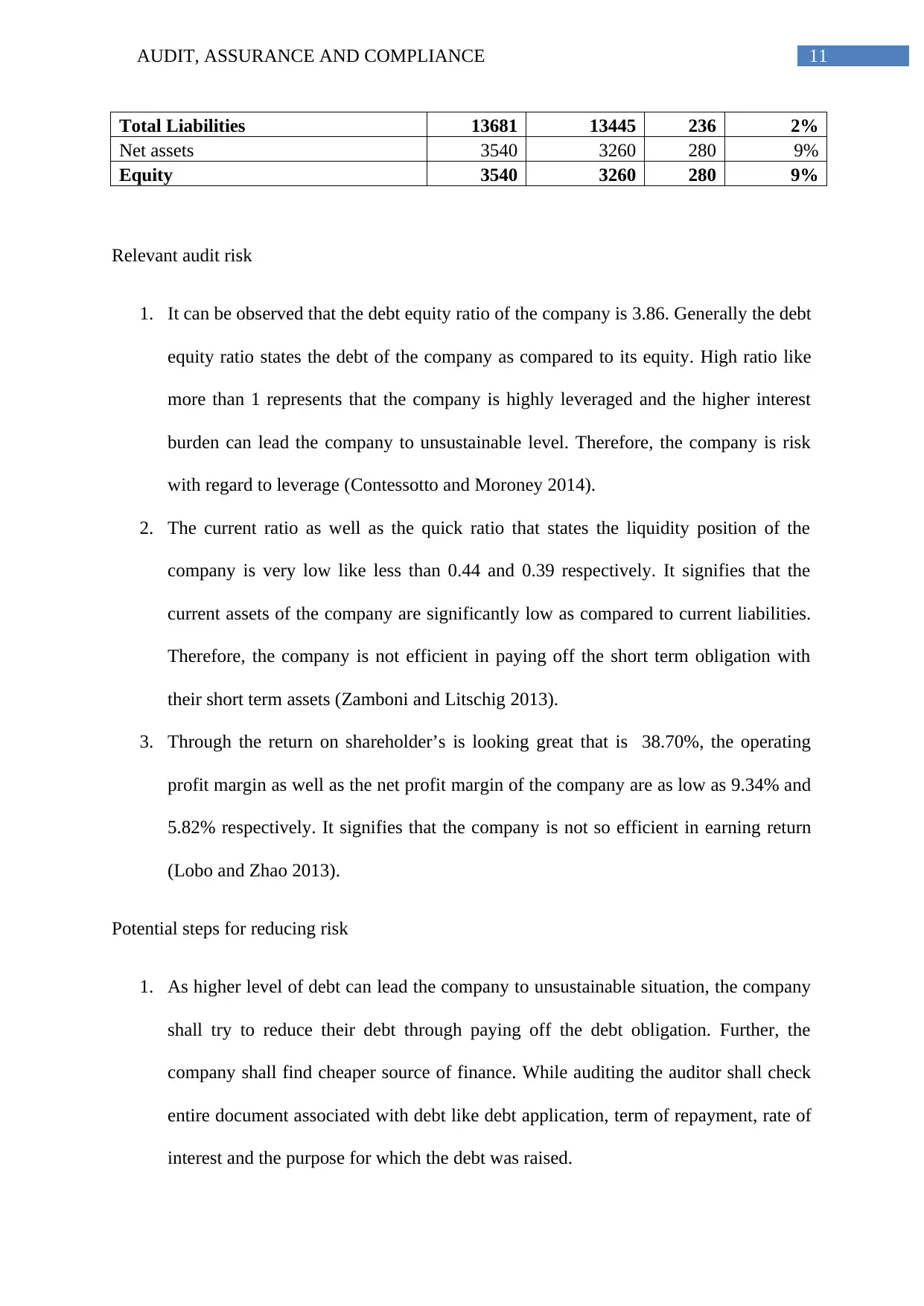
11AUDIT, ASSURANCE AND COMPLIANCE
Total Liabilities 13681 13445 236 2%
Net assets 3540 3260 280 9%
Equity 3540 3260 280 9%
Relevant audit risk
1. It can be observed that the debt equity ratio of the company is 3.86. Generally the debt
equity ratio states the debt of the company as compared to its equity. High ratio like
more than 1 represents that the company is highly leveraged and the higher interest
burden can lead the company to unsustainable level. Therefore, the company is risk
with regard to leverage (Contessotto and Moroney 2014).
2. The current ratio as well as the quick ratio that states the liquidity position of the
company is very low like less than 0.44 and 0.39 respectively. It signifies that the
current assets of the company are significantly low as compared to current liabilities.
Therefore, the company is not efficient in paying off the short term obligation with
their short term assets (Zamboni and Litschig 2013).
3. Through the return on shareholder’s is looking great that is 38.70%, the operating
profit margin as well as the net profit margin of the company are as low as 9.34% and
5.82% respectively. It signifies that the company is not so efficient in earning return
(Lobo and Zhao 2013).
Potential steps for reducing risk
1. As higher level of debt can lead the company to unsustainable situation, the company
shall try to reduce their debt through paying off the debt obligation. Further, the
company shall find cheaper source of finance. While auditing the auditor shall check
entire document associated with debt like debt application, term of repayment, rate of
interest and the purpose for which the debt was raised.
Total Liabilities 13681 13445 236 2%
Net assets 3540 3260 280 9%
Equity 3540 3260 280 9%
Relevant audit risk
1. It can be observed that the debt equity ratio of the company is 3.86. Generally the debt
equity ratio states the debt of the company as compared to its equity. High ratio like
more than 1 represents that the company is highly leveraged and the higher interest
burden can lead the company to unsustainable level. Therefore, the company is risk
with regard to leverage (Contessotto and Moroney 2014).
2. The current ratio as well as the quick ratio that states the liquidity position of the
company is very low like less than 0.44 and 0.39 respectively. It signifies that the
current assets of the company are significantly low as compared to current liabilities.
Therefore, the company is not efficient in paying off the short term obligation with
their short term assets (Zamboni and Litschig 2013).
3. Through the return on shareholder’s is looking great that is 38.70%, the operating
profit margin as well as the net profit margin of the company are as low as 9.34% and
5.82% respectively. It signifies that the company is not so efficient in earning return
(Lobo and Zhao 2013).
Potential steps for reducing risk
1. As higher level of debt can lead the company to unsustainable situation, the company
shall try to reduce their debt through paying off the debt obligation. Further, the
company shall find cheaper source of finance. While auditing the auditor shall check
entire document associated with debt like debt application, term of repayment, rate of
interest and the purpose for which the debt was raised.
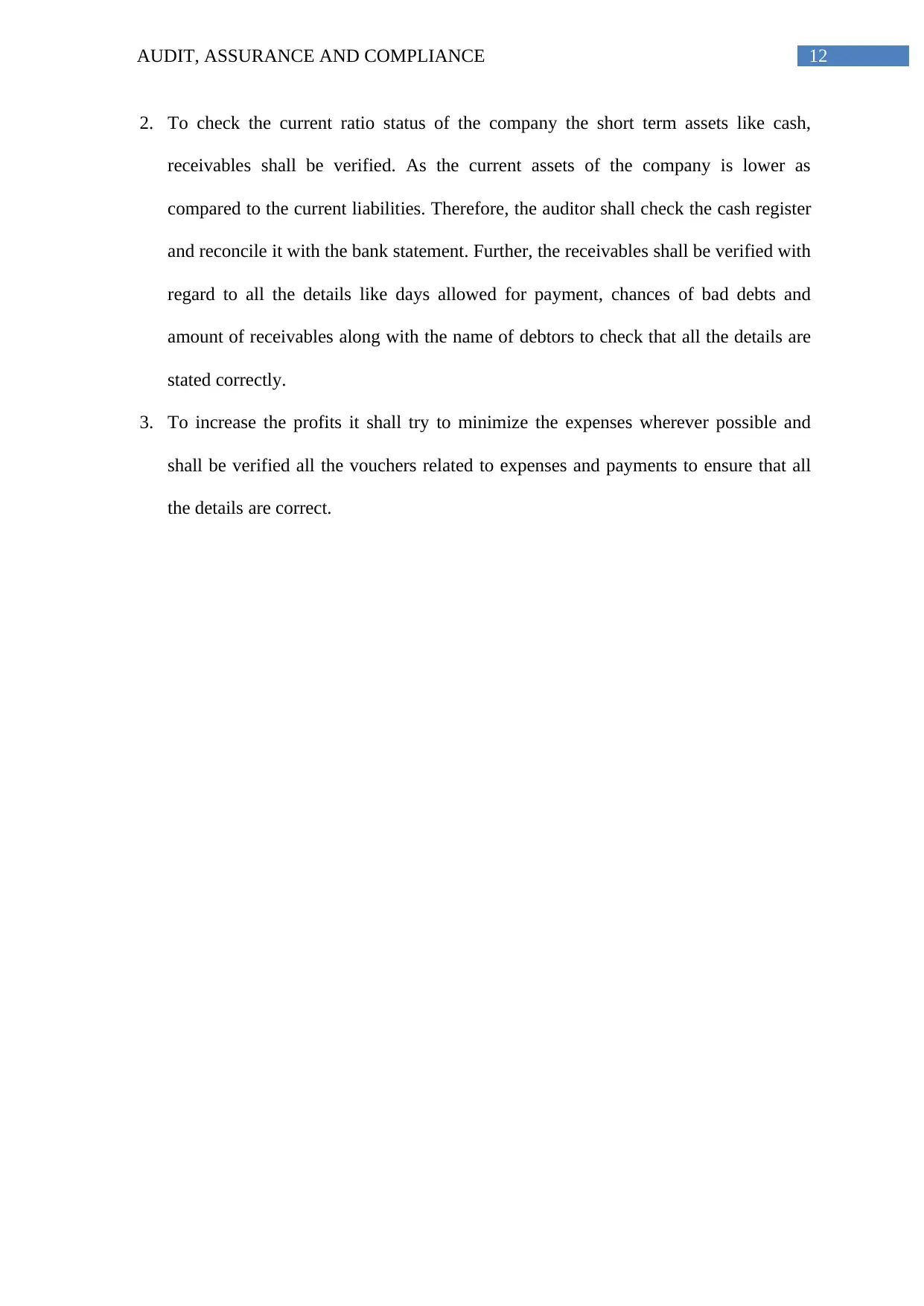
12AUDIT, ASSURANCE AND COMPLIANCE
2. To check the current ratio status of the company the short term assets like cash,
receivables shall be verified. As the current assets of the company is lower as
compared to the current liabilities. Therefore, the auditor shall check the cash register
and reconcile it with the bank statement. Further, the receivables shall be verified with
regard to all the details like days allowed for payment, chances of bad debts and
amount of receivables along with the name of debtors to check that all the details are
stated correctly.
3. To increase the profits it shall try to minimize the expenses wherever possible and
shall be verified all the vouchers related to expenses and payments to ensure that all
the details are correct.
2. To check the current ratio status of the company the short term assets like cash,
receivables shall be verified. As the current assets of the company is lower as
compared to the current liabilities. Therefore, the auditor shall check the cash register
and reconcile it with the bank statement. Further, the receivables shall be verified with
regard to all the details like days allowed for payment, chances of bad debts and
amount of receivables along with the name of debtors to check that all the details are
stated correctly.
3. To increase the profits it shall try to minimize the expenses wherever possible and
shall be verified all the vouchers related to expenses and payments to ensure that all
the details are correct.
Paraphrase This Document
Need a fresh take? Get an instant paraphrase of this document with our AI Paraphraser
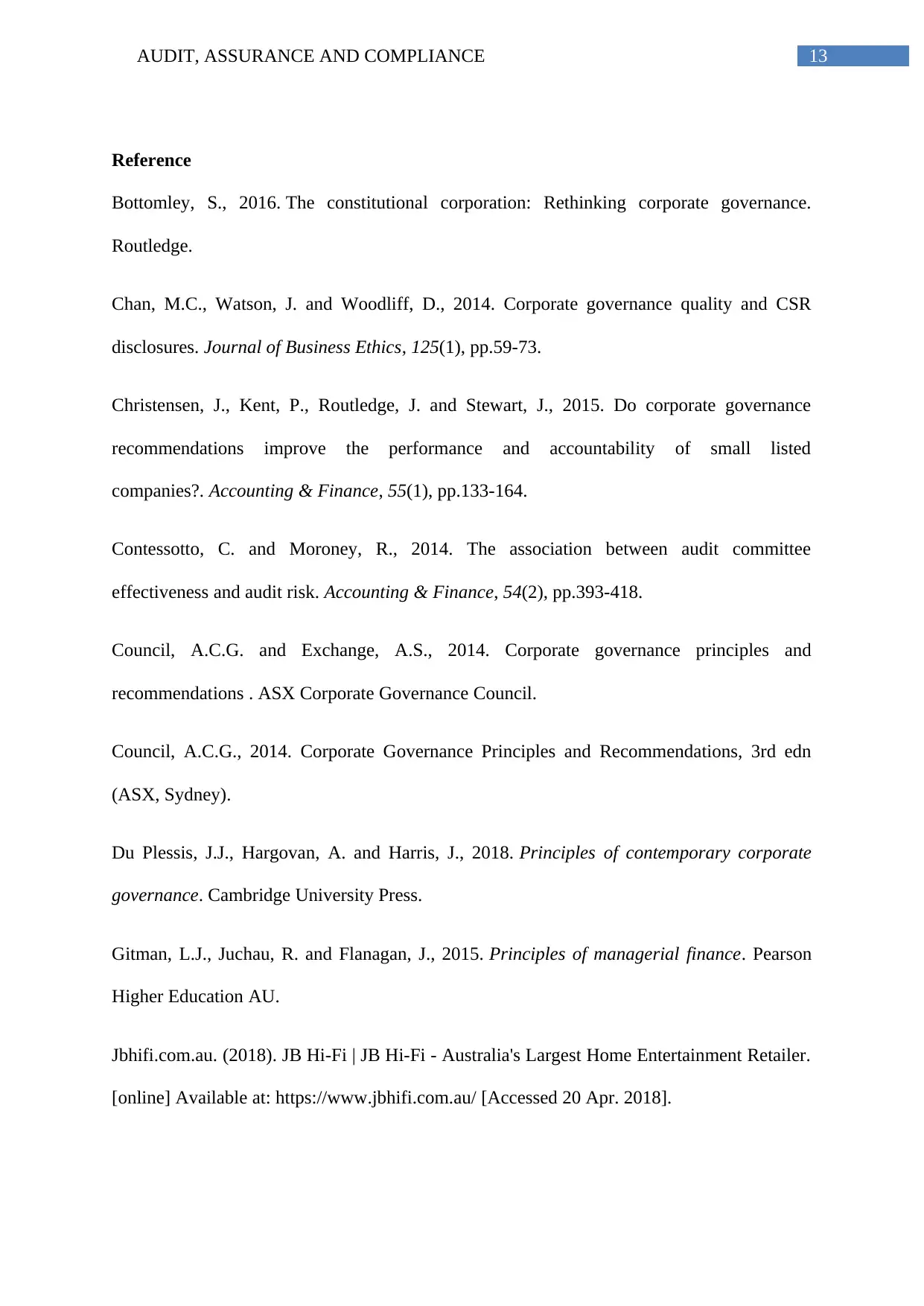
13AUDIT, ASSURANCE AND COMPLIANCE
Reference
Bottomley, S., 2016. The constitutional corporation: Rethinking corporate governance.
Routledge.
Chan, M.C., Watson, J. and Woodliff, D., 2014. Corporate governance quality and CSR
disclosures. Journal of Business Ethics, 125(1), pp.59-73.
Christensen, J., Kent, P., Routledge, J. and Stewart, J., 2015. Do corporate governance
recommendations improve the performance and accountability of small listed
companies?. Accounting & Finance, 55(1), pp.133-164.
Contessotto, C. and Moroney, R., 2014. The association between audit committee
effectiveness and audit risk. Accounting & Finance, 54(2), pp.393-418.
Council, A.C.G. and Exchange, A.S., 2014. Corporate governance principles and
recommendations . ASX Corporate Governance Council.
Council, A.C.G., 2014. Corporate Governance Principles and Recommendations, 3rd edn
(ASX, Sydney).
Du Plessis, J.J., Hargovan, A. and Harris, J., 2018. Principles of contemporary corporate
governance. Cambridge University Press.
Gitman, L.J., Juchau, R. and Flanagan, J., 2015. Principles of managerial finance. Pearson
Higher Education AU.
Jbhifi.com.au. (2018). JB Hi-Fi | JB Hi-Fi - Australia's Largest Home Entertainment Retailer.
[online] Available at: https://www.jbhifi.com.au/ [Accessed 20 Apr. 2018].
Reference
Bottomley, S., 2016. The constitutional corporation: Rethinking corporate governance.
Routledge.
Chan, M.C., Watson, J. and Woodliff, D., 2014. Corporate governance quality and CSR
disclosures. Journal of Business Ethics, 125(1), pp.59-73.
Christensen, J., Kent, P., Routledge, J. and Stewart, J., 2015. Do corporate governance
recommendations improve the performance and accountability of small listed
companies?. Accounting & Finance, 55(1), pp.133-164.
Contessotto, C. and Moroney, R., 2014. The association between audit committee
effectiveness and audit risk. Accounting & Finance, 54(2), pp.393-418.
Council, A.C.G. and Exchange, A.S., 2014. Corporate governance principles and
recommendations . ASX Corporate Governance Council.
Council, A.C.G., 2014. Corporate Governance Principles and Recommendations, 3rd edn
(ASX, Sydney).
Du Plessis, J.J., Hargovan, A. and Harris, J., 2018. Principles of contemporary corporate
governance. Cambridge University Press.
Gitman, L.J., Juchau, R. and Flanagan, J., 2015. Principles of managerial finance. Pearson
Higher Education AU.
Jbhifi.com.au. (2018). JB Hi-Fi | JB Hi-Fi - Australia's Largest Home Entertainment Retailer.
[online] Available at: https://www.jbhifi.com.au/ [Accessed 20 Apr. 2018].
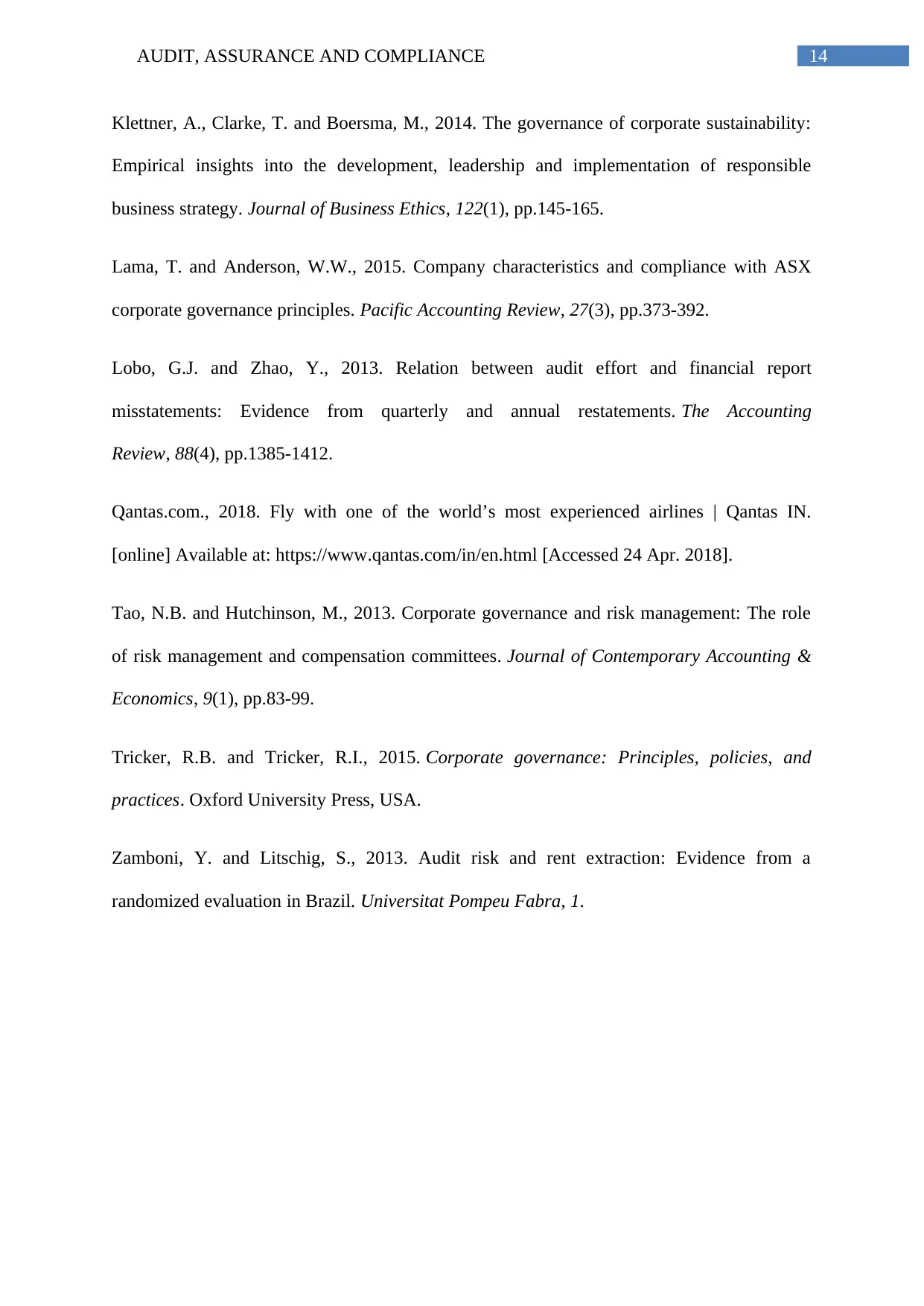
14AUDIT, ASSURANCE AND COMPLIANCE
Klettner, A., Clarke, T. and Boersma, M., 2014. The governance of corporate sustainability:
Empirical insights into the development, leadership and implementation of responsible
business strategy. Journal of Business Ethics, 122(1), pp.145-165.
Lama, T. and Anderson, W.W., 2015. Company characteristics and compliance with ASX
corporate governance principles. Pacific Accounting Review, 27(3), pp.373-392.
Lobo, G.J. and Zhao, Y., 2013. Relation between audit effort and financial report
misstatements: Evidence from quarterly and annual restatements. The Accounting
Review, 88(4), pp.1385-1412.
Qantas.com., 2018. Fly with one of the world’s most experienced airlines | Qantas IN.
[online] Available at: https://www.qantas.com/in/en.html [Accessed 24 Apr. 2018].
Tao, N.B. and Hutchinson, M., 2013. Corporate governance and risk management: The role
of risk management and compensation committees. Journal of Contemporary Accounting &
Economics, 9(1), pp.83-99.
Tricker, R.B. and Tricker, R.I., 2015. Corporate governance: Principles, policies, and
practices. Oxford University Press, USA.
Zamboni, Y. and Litschig, S., 2013. Audit risk and rent extraction: Evidence from a
randomized evaluation in Brazil. Universitat Pompeu Fabra, 1.
Klettner, A., Clarke, T. and Boersma, M., 2014. The governance of corporate sustainability:
Empirical insights into the development, leadership and implementation of responsible
business strategy. Journal of Business Ethics, 122(1), pp.145-165.
Lama, T. and Anderson, W.W., 2015. Company characteristics and compliance with ASX
corporate governance principles. Pacific Accounting Review, 27(3), pp.373-392.
Lobo, G.J. and Zhao, Y., 2013. Relation between audit effort and financial report
misstatements: Evidence from quarterly and annual restatements. The Accounting
Review, 88(4), pp.1385-1412.
Qantas.com., 2018. Fly with one of the world’s most experienced airlines | Qantas IN.
[online] Available at: https://www.qantas.com/in/en.html [Accessed 24 Apr. 2018].
Tao, N.B. and Hutchinson, M., 2013. Corporate governance and risk management: The role
of risk management and compensation committees. Journal of Contemporary Accounting &
Economics, 9(1), pp.83-99.
Tricker, R.B. and Tricker, R.I., 2015. Corporate governance: Principles, policies, and
practices. Oxford University Press, USA.
Zamboni, Y. and Litschig, S., 2013. Audit risk and rent extraction: Evidence from a
randomized evaluation in Brazil. Universitat Pompeu Fabra, 1.
1 out of 15
Related Documents
Your All-in-One AI-Powered Toolkit for Academic Success.
+13062052269
info@desklib.com
Available 24*7 on WhatsApp / Email
![[object Object]](/_next/static/media/star-bottom.7253800d.svg)
Unlock your academic potential
© 2024 | Zucol Services PVT LTD | All rights reserved.




